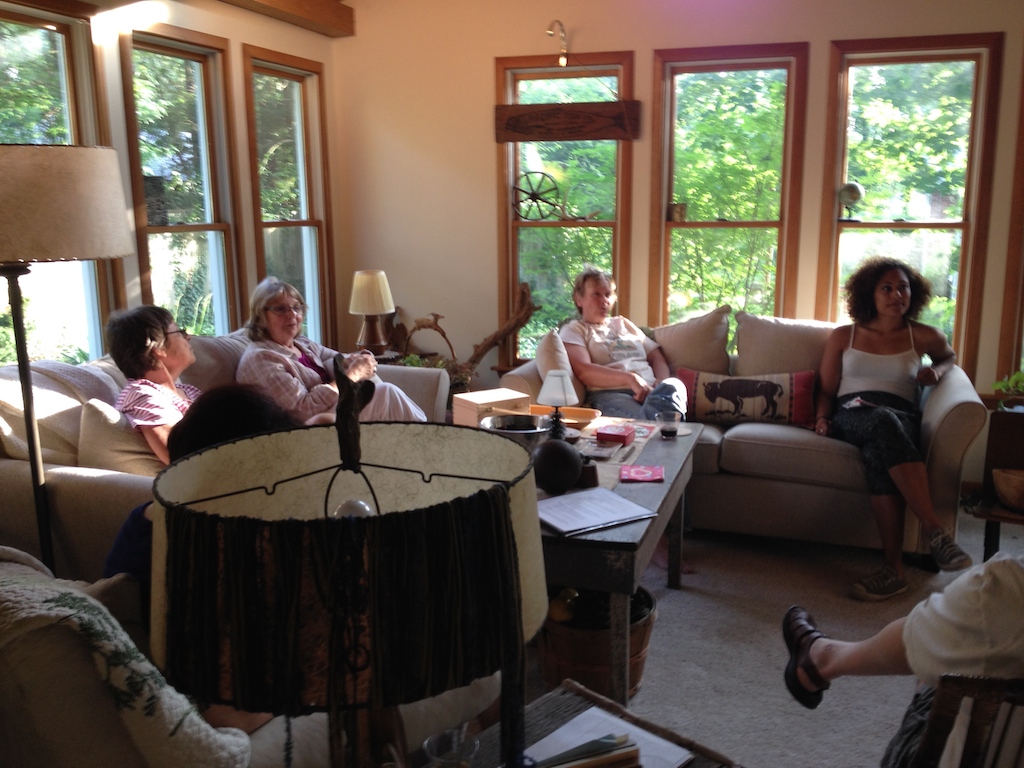Nine Green Acres neighbors met in Georgia and Bill’s lovely “Montana Room” (so named from their fond memories of the year they spent in Bozeman, at Montana State University). Since I’m a westerner, I hadn’t even noticed that yes, the room does have a western theme! (As does the nearby bathroom and Georgia’s office).
Eating mostly salads on a sultry evening, we enjoyed each other and, at my urging, passed around some of the wonderful collages that Georgia creates. And that led us to talking about the “ecowarriors” created by Harmony students that are about to go up on the outside walls of the DeKist House next to the GANG garden; how we want to include other art, public art, as we continue our slow, gradual transformation from neighborhood into ecovillage. (BTW: the technical name for what we are doing is “retrofit ecovillage.” In other words, we don’t build from the ground up, but instead change perceptions in our existing neighborhoods towards more of a sharing economy, where we depend on one another for some of our needs, rather than thinking we all have to do and have everything on our own. An example in our neighborhood is the GANG garden.)
Rebecca brought up the idea of having a weekly or bi-weekly get together, where we gather to do our own art, and share it in conversation with others. Weaving, collages, other art, journal work, whatever! We even thought of a name, the Soul Sisters (and Brothers?) Montana Group, since we’d like to meet in that same wonderful room. Joke? Not sure. We’ll see.
This light-hearted focus was a far cry from the intended agenda of the evening, a talk by Antonya Wallace, a new neighbor and AmeriCorps worker with the City of Bloomington. Antonya had presented her “You can build a NEIGHBORHOOD DISASTER PLAN in just 5 steps” to CONA (Council of Neighborhood Associations), hoping that individual neighborhood associations would then invite her to speak.
Well, guess what? She told us that Green Acres was the only neighborhood that contacted her!
(812-325-4159, wallacea@bloomington.in.gov)
She was surprised, as were we. But then we should get used to the idea that Green Acres does seem habitually ahead of the curve. After all, we were the first neighborhood in the city to make sustainability the keynote of our official plan as filed with the city! So apparently, we’re going to be the first neighborhood to actually admit that a disaster could happen — of whatever kind, natural (tornado, flood, earthquake) or man-made (e.g., spilled poisons from a tipped over truck on the Bypass or a train derailment; a crazed shooter, an extended power outage, and who knows what else!) — and it behooves us to be prepared.
Not only that, but as we focus on creating our disaster plan, we build our interconnectivity as a neighborhood — itself the most important thing we can do to help us all feel safe, no matter what.
Here, in outline form, is the summary of the “5 steps” needed to create a Disaster Plan.
First, realize that we need to divide disaster planning into Before, During and After. Most of the planning is, hopefully, BEFORE!
BEFORE
Step One: Define your area: how many households and people? Language barriers? What buildings or safe places exist? Where are the roads, entrance/exit points, hills, waterways.
Step Two: Recruit leaders: two groups — those to help with planning, and those to help with response.
Step Three: Scout your area. What are our threats? Determine our resources (transportation, EMT people, equipment, supplies). Discuss pros and cons of our landscape. Do we have any obstacles that would make entry/exit difficult? And most important: know your neighbors (skills/training, resources, make a neighborhood contact list (with people per household). What are the limitations (disability, elderly, children, etc.). Establish a system for lost/found pets. Establish a neighborhood gathering place. Need a care center for people who need extra help. First aid location.
Step Four: Build your team. Leaders should represent our community diversity (language, age, disability).
Step Five: Plan your strategy. Select leader for the overall effort. Develop an action plan. Establish teams of 307 people (communications, core, materials/supplies, search & rescue, transport, information team, rescue progress team.
—
This a lot to take in, and while it seems premature to establish a disaster plan now, if and when we are in the middle of a disaster, we will be very glad we did.
Thank you Antonya!
P.S. I asked her to please send us some further links. Which she did, below.
Here are some free FEMA trainings that I recommend:
IS-00022 (An in-depth guide to citizen preparedness)
IS-00394.A (protecting your home or small business from disaster)
IS-00010.A (Animals in disaster: awareness and Preparedness)
IS-00366 (Planning for the needs of children in disasters)
IS-00909 (Community Preparedness: implementing simple activities for everyone)
To access the trainings go to this link http://training.fema.gov/IS/crslist.aspx and type in the code in the bar on the top-right
Of course there are many more but I think that is a good foundation. There are a lot of elements that overlap, so its not too much work. After you finish them FEMA will send you a certification!
I’m not sure what PDFs you want, so I’ll just attach a few, and you can let me know what else you’re looking for!
Here is the neighborhood 5 step plan that I gave you: http://emergency.lacity.org/stellent/groups/departments/@emd_contributor/documents/contributor_web_content/lacityp_024010.pdf
Disaster planning for seniors by seniors:
http://www.redcross.org/images/MEDIA_CustomProductCatalog/m4640086_Disaster_Preparedness_for_Srs-English.revised_7-09.pdf
Overview of animals in disaster:
http://www.ready.gov/caring-animals
Preparing for disaster for people with disabilities or functional needs:
http://www.ready.gov/individuals-access-functional-needs
What to have in your home disaster kit:
http://www.ready.gov/kit
WATER!
http://www.ready.gov/water
The ready.gov site has a lot of helpful information on it.
Click below for Antonya’s emergency preparedness card:
